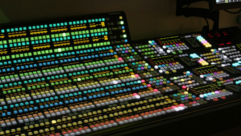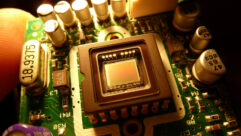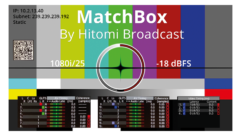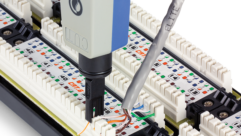
Video Production Basics
Jan 1, 2005 12:00 PM,
By David Riffle
Help your clients determine what they need.
JVC’s JY-HD10 camcorder captures HDV, a relatively new consumer HD videotape format that has migrated to the professional realm.
An increasing number of clients of AV systems integrators want to produce their own video. Systems integrators need to be knowledgeable about the basics of video production in order to help clients — whether they’re houses of worship, museums, or Fortune 500 companies — get exactly what they need to suit their production purposes.
As the scale of a video production project increases, so does the need for technical understanding. This article discusses, from an engineering point of view, relevant technical details about video, which I hope will help you plan and direct your integration efforts to better effect for clients who have decided to undertake video production.
VIDEO PRODUCTION END USE
As a video postproduction engineer, I am confronted too frequently with a situation in which a producer has not adequately considered the intended delivery medium of his or her program material. As a result, the producer must contend with unexpected or undesired compromises in the finished product. It is too easy to get immersed in the details of the production only to find that the finished program material, so meticulously derived, does not suit the delivery medium or end-user viewing environment. Most of these types of disappointments can be avoided if the production goals and technical equipment are chosen to be consistent with the way the program will finally be viewed.
Therefore, I will start by looking at the display end of the production project and discussing the appropriate equipment and processes all the way back up the chain from there. It is helpful to evaluate the intended viewing medium and environment, and then design the production equipment and formats to suit that.
One of the first considerations, then, is the size and type of display on which the programming is expected to be viewed. A small TV set as used in a kiosk does not have the resolution to justify high-end HD production equipment, for instance. But if the programming will be projected onto a 24ft. screen in a sanctuary or theater, the more resolution the budget will allow, the better! Conversely, a brightly lit viewing environment will not favor fine picture resolution, regardless of the display size. TV broadcasts will also be restricted in resolution by the transmission format and equipment. Audio monitoring in small TV sets is often poor, and frequently even mono channel. Many broadcast transmissions are limited to stereo audio with restricted frequency and dynamic range. By contrast, an auditorium venue such as a sanctuary or theater might have a fantastic, well-balanced speaker system. So let’s take a moment to consider the characteristics of a few of the end displays you might need to accommodate.
DISPLAYS
There is an assortment of display types in common use, each embracing a different technology to accomplish the physical display of a video signal. Fundamentally, the process is the same, though. The three primary colors are extracted from the video signal, and these are used to drive a set of color display elements, as simulated in Figure 1, to varying degrees of brightness. In theory these display elements are able to emit light that is true to the pure primary colors, but in practice they can only approximate those colors.
Some of the various common display technologies are CRT, plasma, and LCD in direct-view displays, and LCD and DLP in projection displays. Each of these technologies possesses valuable properties that favor certain applications.

Figure 1: Close-up approximation of the phosphors in a CRT display.
CRT Displays
Compared to flat panels, traditional CRT displays are comparatively large and rather heavy, but they are also the most common displays available. The technology is very well developed, and CRT displays can command unequaled control over the image clarity, contrast, and color. Because they are so plentiful, the cost for these displays is usually the lowest compared to that of other technologies.
CRT displays are in common use in applications like kiosks, lobbies, production monitoring, and home entertainment. They are very reliable indicators of image quality because they do not tend to introduce technology-related artifacts to the image. Very high-quality broadcast CRT monitors have resolutions around 900 TV lines, but many consumer CRTs are not much better than 300 TVL. HD images look very good on 20in. broadcast HD CRTs with 900 TVL resolution. The smaller the CRT, the lower the native resolution can be while still producing a sharp-looking image, due to the eye’s physical difficulty discerning image details in very small images.
Plasma Displays and LCDs
Plasma and LCD display technologies are both ideally suited for applications in which a large display must be mounted flat against a wall or suspended from a ceiling. These displays are a fraction the weight of comparably sized CRT displays, and they can offer acceptably wide viewing angles and high brightness.
Both of these technologies will be very common in the marketplace for many years to come, and they will continue to improve in display quality, color rendition, and price. As yet, these two technologies have no realistic competition (besides each other) in the applications for which they are best suited. A 42in. widescreen display — either a plasma or an LCD — can produce a respectably sharp image, and is well suited to HD or computer-generated images, especially when viewed from a modest distance.

The Christie LW40, a native widescreen LCD projector with WXGA resolution, would do justice to HD images.
LCD and DLP Projectors
Projection displays can be front- or rear-projection types. In the past few years, rear-projection displays have been vastly improved in terms of viewing quality and size. They have the appearance of large plasma displays or LCDs but use the basic technology of projectors — particularly DLP projectors. Rear-projection displays are still rather large compared to plasmas and LCDs. Still, they find application in areas where there is no space for an unobstructed projection from across the room. Expect HD images to look pretty good on these, but as with any other large screen-display, standard-definition NTSC images can look degraded without special processing measures, such as line doubling.
Front-projection displays have qualities that can accommodate other special applications, such as venues that require a portable or fixed display that throws a very large image. A projector can be light and small and can offer image resolution and quality that equals or surpasses those of the other display types — even at display sizes measured in feet rather than inches. Most small projectors currently have native resolutions of 1024×768 or higher and weights in the 3lb. range. These displays certainly can do justice to HD images.
Speaker Systems
The individual speakers used in small CRT monitors or kiosks vary dramatically in sound quality. Generally, the smaller the speaker, the lower its dynamic range and frequency response. This is somewhat of a parallel to the reduction in resolution as video displays get smaller. Although audio just tends to sound worse as speaker size decreases, video displays appear to get sharper in resolution as they get smaller. It is best to restrict the audio to mono and limit the dynamic range if the intended display will be small or the environment will be noisy.
In venues that are designed for careful lighting and crisp imaging, the sound quality achieved will be more a matter of a speaker “system” than of individual speakers or their respective sizes. These systems should have enough power to fill the area and provide dynamic range and frequency response sufficient to result in a truly pleasant listening experience. In such an environment, surround sound is very effective.
DISTRIBUTION OPTIONS
The next item to consider is the expected distribution media for the completed programming. If a production is to be aired or used in a live presentation, then distribution in this sense is not an issue. But if a production event will be recorded for distribution, the distribution medium will have a significant impact on the program quality.

The Pioneer PRV-LX1 is an industrial-grade DVD recorder with a VCR-like interface and operation.
DVD Formats
The popularity of DVDs is hard to dispute. With the cost of players at a very reasonable level, this is one of the best formats for direct distribution to many individuals. Computer systems with DVD burners and appropriate authoring software can burn a handful of copies. But the most robust and reliable way to produce DVD copies in large numbers is to send a data recording, usually on DLT tape, of the “image” to be burned to a commercial DVD replication facility. There is a difference in the way a DVD is “burned” on a burner and the method in which it is “pressed” by a commercial replicator. Burned DVDs are subject to more interchange issues than I can relate in this article, so consider burning DVDs to be appropriate only for limited and relatively controlled distribution.
If the situation does permit burning DVDs, however, there are several manufacturers that make DVD burners that are designed to simulate the interface and operation of a VCR. One example is the Pioneer PRV-LX1. These burners are industrial-grade, and they are wonderfully simple, fast, and efficient to use.
DVDs are suitable for progressive and interlaced frame video formats and can incorporate surround-sound audio, several audio tracks with multiple languages, and subtitles. Combined with resolution bandwidth that is somewhat higher than that of NTSC television (although not yet at HD levels), DVDs can produce video and audio quality that very nearly approach HD levels, at least perception-wise.

Videotape Formats
VHS has long been the format of choice for the home. S-VHS is a slightly higher-quality format designed for the industrial market. Both are basically somewhat lower in resolution than NTSC television and are reasonably good matches to the resolution characteristics of older NTSC TV sets. It is possible to record surround sound-encoded audio tracks on VHS tape, but typically they contain stereo audio on hi-fi tracks.
If it is not necessary to distribute the program directly to the end user on videotape, but to a cable or TV broadcaster instead, there are quite a few other formats available. DV in its consumer version is not recommended for this task, because of its lack of timecode. DVCAM and DVCPRO, however, are very good choices. These are relatively common formats for postproduction facilities, cable head ends, and TV stations. Both of these are component digital recording and playback formats with better-than-NTSC quality levels.
Other common formats to consider are D9, Digital Betacam, D5, HDCAM, and DVCPRO HD. These are all high-quality component digital formats, and some can accommodate a wide range of video frame rates. One great deterrent to using these formats is the equipment cost, which can hover around $60,000 for a camcorder. Table 1 on p. 46 shows a few of the characteristics of these digital videotape formats.
POSTPRODUCTION
If a video production will be recorded and edited for later distribution or playback, postproduction is necessary. This requires an editing software application and platform that is powerful enough to accommodate all of the necessary effects, graphics, video and audio tracks, and frame size and rate. If the target distribution medium is NTSC television, then the edit platform must be capable of handling at least 30 frames per second (fps) with a frame size of 720×486 pixels, generally while processing at least two streams of video and audio.
If the video production will result in an HD program, the platform could require the processing capability to handle 10-bit pixel-depth frame sizes up to 1920×1080 pixels, at interlaced frame rates of 30fps. This is no small requirement; it will require a robust application and a very reliable complement of hardware, including capacious and fast disk drive storage. That said, there are some wonderful choices available today at reasonable prices.
Nonlinear Editing
NLEs are by far the most popular editing systems today. Due to the power and pricing of computer hardware, these systems are practical for editing material of almost any resolution — although if film resolutions are involved, the hardware can be quite expensive. As you might expect, the higher the resolution and frame rate, the greater the size of the digitized media files and, consequently, the amount of disk storage needed. Effective edit space needed for a 90-minute uncompressed HD project can be as much as 3TB (terabytes). The nature of nonlinear editing means there will be close to five times the amount of material digitized as is used in the final output sequence, and storage space can get somewhat prohibitive in cost.
There are dozens of NLE systems available. The best policy, after budget and performance requirements are satisfied, is to find one that is compatible with the temperament, style, and training of the intended editor. Many editors have a distinct preference for one system over another, and to ignore that fact is to place yourself in the embarrassing position of installing a great system that nobody is able to use very easily. A few of the most common editing applications in use today are Avid Media Composer, Adobe Premiere Pro, and Apple Final Cut Pro HD.
Linear Editing
Linear editing, as the name implies, is editing with one or more source video and audio streams, usually from videotape machines, in a direct and linear fashion. The segments are edited together in a coherent timeline directly onto the recorded master videotape, and changes to that timeline usually require a complete re-edit from the point of change on out to the end of the videotape.
This type of editing is very fast, since it is not necessary to digitize source material, nor to lay off the finished sequence. Video storage is not necessary, but the edits must be well planned or very routine in nature. However, this style of editing can be limiting and inflexible, and facilities must put a lot of money into the features and capabilities of the hardware that comprises the system.
The hardware components that comprise a linear system are an edit controller, a production switcher, a DVE (digital video effects generator), a character generator, videotape machines, and often a DDR (digital disk recorder). Accom, Chyron, Sony, and Panasonic are examples of companies that manufacture one or more of these components.
Audio Sweetening
The audio tracks of a program, no matter what format is chosen, take up only a small fraction of the disk storage space required for the video. It will not require the sheer hardware processing power that video does. Many available digital audio workstations (DAWs) allow a very fine degree of control over the sound and frequency qualities, separation, surround mix, and sampling rate. The catch here is that when video and audio are dealt with separately, there is a real hazard of losing the audio-to-video synchronization.
There are a number of ways to minimize this hazard. It is common to use a video track with visible timecode for reference, or to use video carefully down-converted from HD onto inexpensive videotape to provide the video reference guide for audio work. Essentially, it is necessary to keep the audio timeline on the exact same frame base as the video. This means that before you add equipment or procedures to change audio sample rates, or downconvert HD to NTSC to use it as video reference for HD programming, thoroughly calculate the effect on video delay that any conversion equipment will introduce. You might find that it is appropriate to use audio delay equipment in order to maintain the synch relationships. In typical HD productions, there can be as many as eight different video frame rates.
Because SD formats have different base frame rates for drop-frame and non-drop-frame timecode, and for PAL and NTSC material, the same sorts of opportunities to offset the audio and video timebases crop up here too. Every one of the digital video formats has exactly the same audio sample rate, but some of the conversions from one video format to another involve significant time shifts — which need to be mirrored for the audio!
SOURCE MATERIAL ACQUISITION
The next production detail to consider is the choice of a suitable acquisition medium. If the video elements will be gathered in the field or in the studio, then a good camera and portable recorder will be needed. The most typical and efficient configuration today is the camcorder, which incorporates both functions in one piece.
For many years videotape was the only practical and cost-effective means of program acquisition for mid-range productions. This is still true, even for many high-end productions as HD displaces film in certain applications. (However, manufacturers like Sony and Panasonic have recently released camcorders that use disc-based media and solid-state recording as alternatives to tape.)
On the consumer end of the spectrum is MiniDV, while HDCAM is the format of choice for many on the high end of the spectrum. Digital videotape formats have started to dominate broadcast production in recent years. Some of the best value-oriented digital formats have surfaced first in the consumer market, as is the case with the DV format. Professional productions frequently use this format or its slightly more robust versions, DVCAM, DVCPRO, HDCAM, and DVCPRO HD. A relatively new format to appear is HDV, designed to be a consumer HD recording format and based on MPEG-2 compression and on DV cassette recording technology. The Sony HDR-FX1 is an example of an HDV camcorder.
It is important to decide on the number of audio tracks the finished programming will have, and how many audio tracks will be gathered in the field at one time. The videotape format capabilities will need to match the audio needs, unless separate audio recording equipment will be employed. Again, look at Table 1 to see the characteristics of the different digital videotape formats.
IN SUMMARY
If you follow this process, you will have identified the end use of the programming you are facilitating, and will have considered the distribution media, editing platform, acquisition equipment, and acquisition media to match the characteristics of the final display and environment. Ideally, no stage of the production process will degrade the program quality below the level of the end display. Video productions usually involve many individuals, all of whom must feel comfortable with the operating characteristics of the equipment they are using, so successful equipment integration will depend on a keen insight into this human element as well as the technical parameters!
David Riffleis the CTO for Video Arts, Inc., a San Francisco-based video postproduction facility. With over 20 years experience in the video industry, Dave has worked both in broadcast and postproduction environments.
Web Exclusive
BASIC TRAINING
For more on video production, including the basics of camcorder and imaging technology, click here.










